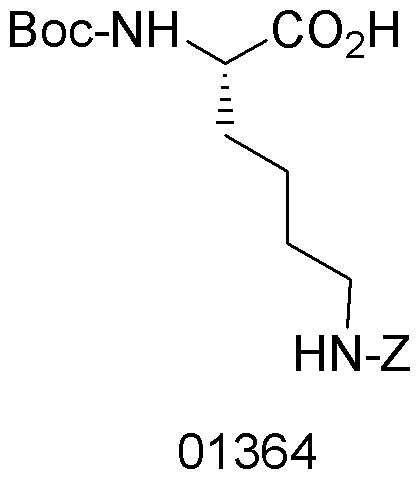Na-Boc-Ne-Z-L-lysine is widely utilized in research focused on:
- Peptide Synthesis: This compound serves as a key building block for synthesizing peptides, allowing researchers to create complex structures for drug development and biological studies.
- Bioconjugation: It is employed in bioconjugation processes, where it helps attach biomolecules to surfaces or other molecules, enhancing the efficacy of targeted drug delivery systems.
- Protein Engineering: Researchers use it to modify proteins, improving their stability and functionality, which is essential in developing therapeutic proteins and enzymes.
- Diagnostics: The compound plays a role in the development of diagnostic tools, particularly in assays that require specific peptide interactions, aiding in disease detection.
- Research on Drug Resistance: It is utilized in studies aimed at understanding and overcoming drug resistance in cancer treatments, providing insights that can lead to more effective therapies.
Informations générales
Propriétés
Sécurité et réglementation
Applications
Na-Boc-Ne-Z-L-lysine is widely utilized in research focused on:
- Peptide Synthesis: This compound serves as a key building block for synthesizing peptides, allowing researchers to create complex structures for drug development and biological studies.
- Bioconjugation: It is employed in bioconjugation processes, where it helps attach biomolecules to surfaces or other molecules, enhancing the efficacy of targeted drug delivery systems.
- Protein Engineering: Researchers use it to modify proteins, improving their stability and functionality, which is essential in developing therapeutic proteins and enzymes.
- Diagnostics: The compound plays a role in the development of diagnostic tools, particularly in assays that require specific peptide interactions, aiding in disease detection.
- Research on Drug Resistance: It is utilized in studies aimed at understanding and overcoming drug resistance in cancer treatments, providing insights that can lead to more effective therapies.
Documents
Fiches de données de sécurité (FDS)
La FDS fournit des informations de sécurité complètes sur la manipulation, le stockage et l’élimination du produit.
Spécifications du produit (PS)
Le PS fournit une description complète des propriétés du produit, notamment sa composition chimique, son état physique, sa pureté et les exigences de stockage. Il détaille également les plages de qualité acceptables et les applications prévues du produit.
Certificats d'analyse (COA)
Recherchez des certificats d'analyse (COA) en saisissant le numéro de lot du produit. Les numéros de lot et de lot se trouvent sur l'étiquette d'un produit, après les mots « Lot » ou « Lot de fabrication ».
Numéro de catalogue
Numéro de lot/série
Certificats d'origine (COO)
Ce certificat d'exploitation confirme le pays dans lequel le produit a été fabriqué, et détaille également les matériaux et composants utilisés et s'il est issu de sources naturelles, synthétiques ou autres sources spécifiques. Ce certificat peut être requis pour les douanes, le commerce et la conformité réglementaire.
Numéro de catalogue
Numéro de lot/série
Fiches de données de sécurité (FDS)
La FDS fournit des informations de sécurité complètes sur la manipulation, le stockage et l’élimination du produit.
DownloadSpécifications du produit (PS)
Le PS fournit une description complète des propriétés du produit, notamment sa composition chimique, son état physique, sa pureté et les exigences de stockage. Il détaille également les plages de qualité acceptables et les applications prévues du produit.
DownloadCertificats d'analyse (COA)
Recherchez des certificats d'analyse (COA) en saisissant le numéro de lot du produit. Les numéros de lot et de lot se trouvent sur l'étiquette d'un produit, après les mots « Lot » ou « Lot de fabrication ».
Numéro de catalogue
Numéro de lot/série
Certificats d'origine (COO)
Ce certificat d'exploitation confirme le pays dans lequel le produit a été fabriqué, et détaille également les matériaux et composants utilisés et s'il est issu de sources naturelles, synthétiques ou autres sources spécifiques. Ce certificat peut être requis pour les douanes, le commerce et la conformité réglementaire.


